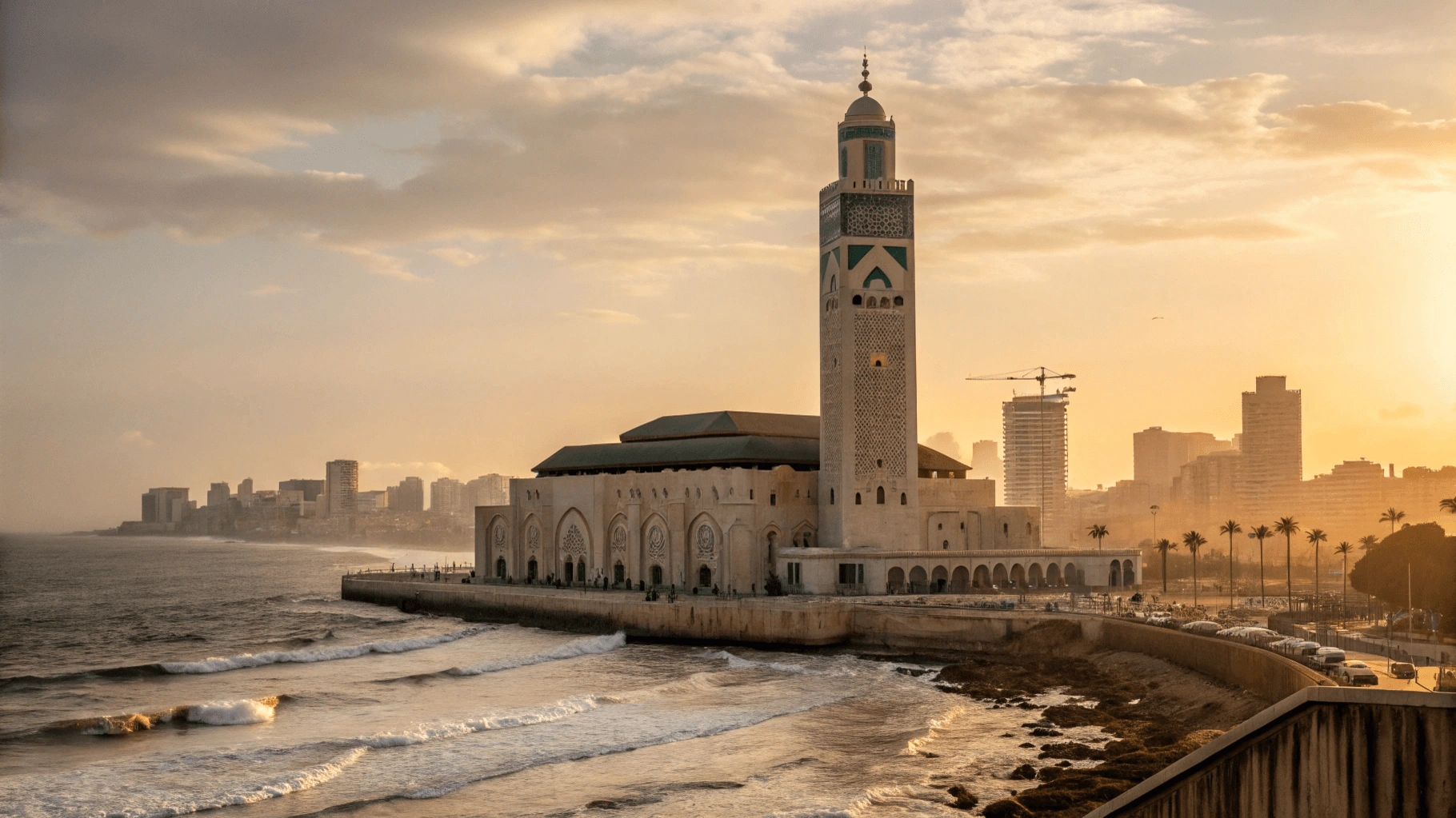Last Updated: May 1, 2025
Introduction: Discovering Casablanca Beyond the Business Hub
Most visitors to Morocco rush through Casablanca, dismissing it as merely a business center lacking the charm of Marrakech or the historical significance of Fes. But after spending two intensive weeks exploring every corner of this vibrant coastal metropolis, I can confidently say this conventional wisdom couldn’t be more wrong.
Casablanca—or “Casa” as locals affectionately call it—offers a fascinating blend of traditional Moroccan culture with French colonial influence, stunning Art Deco architecture, magnificent religious sites, and a cosmopolitan energy you won’t find elsewhere in Morocco. “things to do in casablanca morocco”
This comprehensive guide goes beyond surface-level tourism to reveal Casablanca’s true character—from iconic landmarks and hidden cultural gems to mouthwatering cuisine and practical local insights that will transform your visit from ordinary to extraordinary.
Table of Contents
Quick Reference: Top 5 Unmissable Experiences in Casablanca
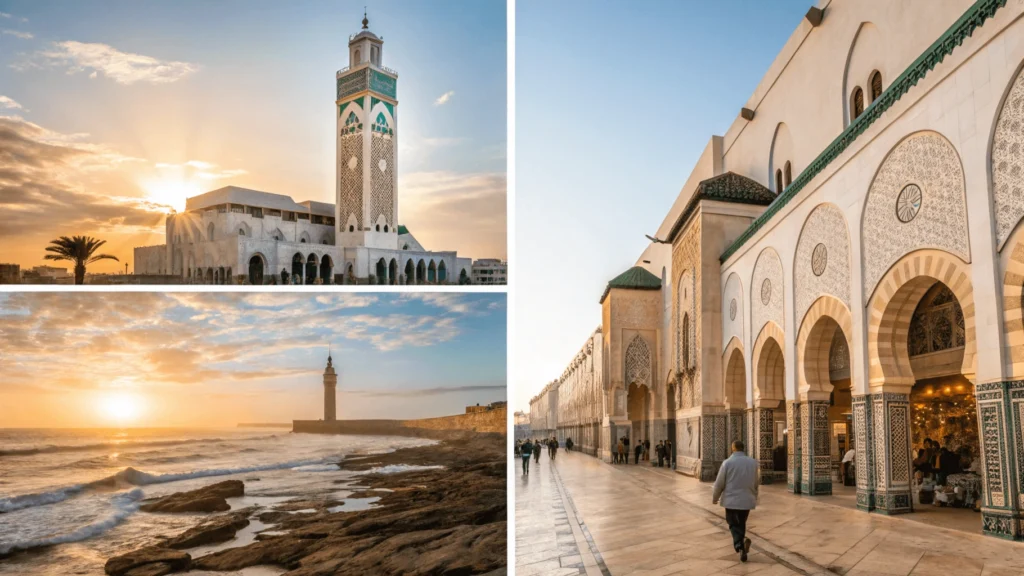
For those short on time, here are the absolute must-do experiences in Casablanca:
- Marvel at the Hassan II Mosque – One of the world’s largest mosques with breathtaking ocean views and intricate craftsmanship “things to do in casablanca morocco”
- Wander through the Old Medina – Experience authentic Moroccan market life and architecture
- Explore Art Deco architecture in the city center – Discover Casablanca’s unique architectural heritage
- Stroll along the Corniche – Enjoy the Atlantic coastline, beaches, and seafood restaurants
- Experience local cuisine at Central Market – Sample fresh seafood and traditional Moroccan dishes
Continue reading for detailed information about each of these experiences and many more hidden gems!
Major Landmarks & Attractions
Hassan II Mosque
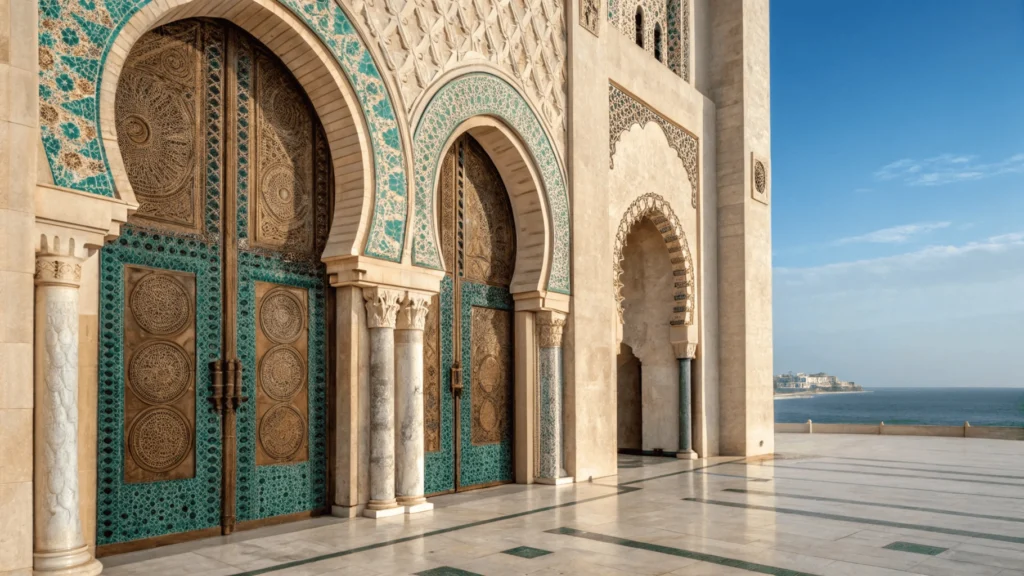
What it is:
The Hassan II Mosque is Morocco’s largest mosque and one of the most impressive religious buildings in the world. Built partly over the Atlantic Ocean, this architectural masterpiece can accommodate 25,000 worshippers inside and another 80,000 in its courtyard.
Why Visit:
Unlike most mosques in Morocco, the Hassan II Mosque welcomes non-Muslim visitors through guided tours. The craftsmanship is simply astounding—hand-carved cedar, intricate zellige tile work, stunning marble floors, and a retractable roof. The mosque’s 210-meter minaret is the tallest religious structure in the world and serves as Casablanca’s defining landmark. “things to do in casablanca morocco”
Insider Tips:
- Visit during the late afternoon tour (around 3-4 PM) for the most spectacular lighting conditions inside the prayer hall.
- Bring a wide-angle lens if you’re a photographer—the interior spaces are massive.
- Women must cover their shoulders and knees (men too should dress modestly).
- The guided tours last about an hour, but allow extra time for security checks and admiring the exterior.
- The plaza surrounding the mosque offers excellent photo opportunities, especially at sunset.
Practical Info:
- Address: Blvd Sidi Mohammed Ben Abdallah
- Hours: Tours available daily except Fridays, at 9 AM, 10 AM, 11 AM, 2 PM, and 3 PM
- Entrance Fee: 140 MAD (about $14 USD)
- Website: Hassan II Mosque Foundation
- Getting There: Located along the seafront—easily accessible by petit taxi or the tram to Hassan II stop + 10-minute walk
The Old Medina
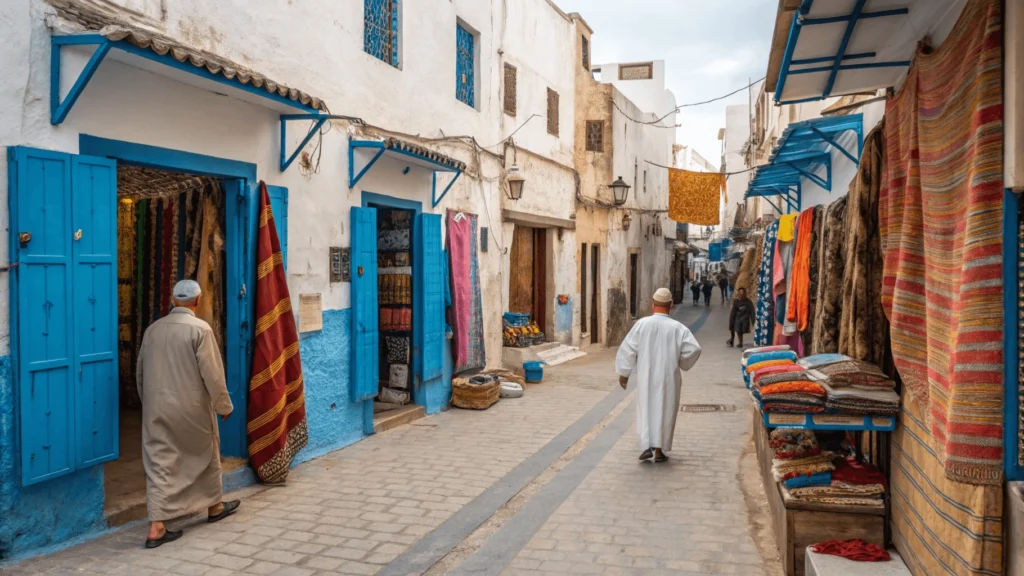
What it is:
Casablanca’s historic walled city dates back to the 18th century, though it’s less preserved than medinas in other Moroccan cities. Nevertheless, it offers an authentic glimpse into traditional Moroccan urban life with its narrow winding streets, small shops, and local character.
Why Visit:
While more chaotic and less tourist-oriented than other Moroccan medinas, Casablanca’s Old Medina provides a genuine, unfiltered experience of daily Moroccan life. The contrast between the modern city and this traditional enclave makes it particularly fascinating.
Insider Tips:
- Enter through Bab Marrakech gate on the south side for easier orientation.
- The morning (9-11 AM) is best for a calmer experience with fewer crowds.
- Bargaining is expected but keep it friendly—start at about 40% of the initial asking price.
- The jewelry quarter on the northeast section has some of the more interesting shops.
- Wear comfortable closed shoes as the ground can be uneven and occasionally wet.
- Keep valuables secure—while generally safe, it’s still a crowded area.
Practical Info:
- Address: Northeast of United Nations Square
- Hours: Generally 8 AM to 8 PM, though individual shops vary (many closed Friday afternoons)
- Entrance Fee: Free
- Getting There: A short walk north from United Nations Square or Mohammed V Boulevard
Habous Quarter (New Medina)
What it is:
Created by the French in the 1930s, the Habous Quarter is a more orderly, planned version of a traditional medina. It was designed to combine Moroccan architectural elements with modern urban planning.
Why Visit:
The Habous Quarter offers a more relaxed shopping experience than the Old Medina, with beautiful arcades, organized souks, and some of the city’s best artisanal shops. The neighborhood is home to the Royal Palace (not open to visitors), beautiful mosques, and excellent pastry shops.
Insider Tips:
- Visit Patisserie Bennis for the best Moroccan pastries in the city—arrive early as popular items sell out.
- The olive market offers dozens of varieties—vendors will let you sample before buying.
- Shop for leather goods here rather than in the Old Medina—quality tends to be higher.
- The area around Mahkama du Pacha (a beautiful former courthouse) is less crowded and great for photos.
- Visit on weekday mornings to avoid crowds of local shoppers.
Practical Info:
- Address: Southeast of city center, near the Royal Palace
- Hours: Most shops open 9 AM-7 PM, closed or limited hours during Friday prayers (12-2 PM)
- Entrance Fee: Free
- Getting There: Petit taxi from city center (about 15-20 MAD) or tram to Marché Central + 15-minute walk
Corniche and Ain Diab Beach
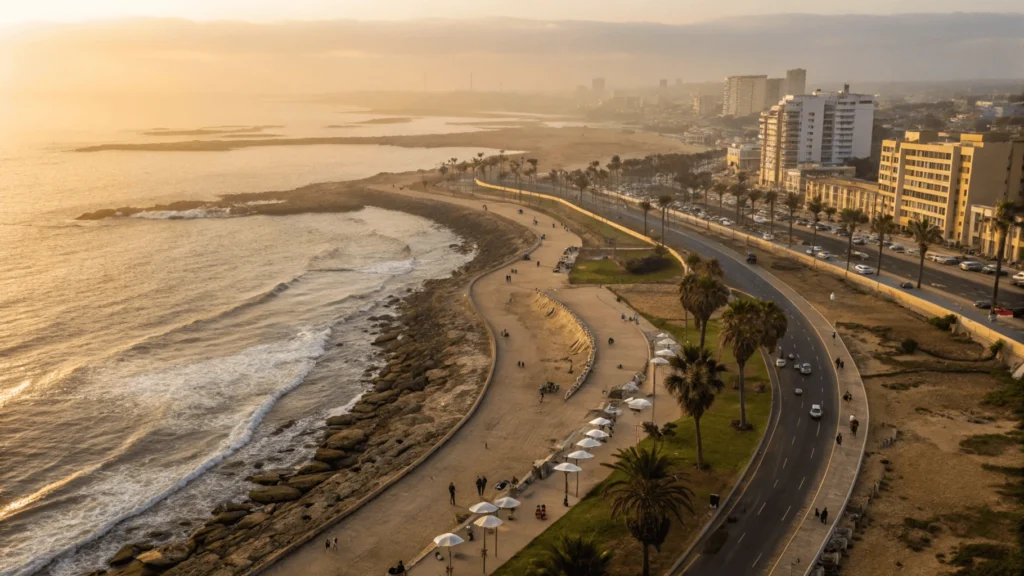
What it is:
The Corniche is Casablanca’s seaside boulevard stretching along the Atlantic coast, culminating in the upscale Ain Diab beach area. It’s where locals go to escape the city’s hustle, enjoy the sea breeze, and socialize.
Why Visit:
The area offers a refreshing contrast to the busy city center with its ocean views, beach clubs, swimming pools, restaurants, and nightlife options. It shows a completely different side of Casablanca—relaxed, recreational, and modern.
Insider Tips:
- Public beaches can get very crowded on weekends; visit on weekdays if possible.
- Beach clubs like Tahiti Beach Club offer day passes with pool access, loungers, and better facilities (150-300 MAD per person).
- Sunset is the perfect time to stroll the promenade and watch locals fishing along the rocks.
- The best seafood restaurants are in the middle section of the Corniche—try La Mer for incredible views and fresh catches.
- Dress modestly on public beaches; private clubs are more relaxed about attire.
Practical Info:
- Address: Western coastal area of Casablanca
- Hours: Public access 24/7 (beach clubs and restaurants have individual hours)
- Entrance Fee: Free for public areas; beach clubs charge entry fees
- Getting There: Tram to Ain Diab terminus or petit taxi (about 25-30 MAD from city center)
Morocco Mall
What it is:
One of Africa’s largest shopping centers, Morocco Mall is an ultra-modern retail complex featuring international brands, entertainment options, and an impressive aquarium.
Why Visit:
Beyond shopping, the mall offers insight into contemporary Moroccan urban culture. It’s where fashionable Casablancans socialize, dine, and enjoy entertainment. The central aquarium, IMAX theater, and musical fountain show make it a destination even for non-shoppers.
Insider Tips:
- The musical fountain shows run every hour on the hour from noon to 9 PM.
- Visit the traditional Moroccan souk section on the upper floor for local products with fixed prices.
- The food court offers good value meals, while the oceanfront restaurants provide nicer ambiance at higher prices.
- The aquarium’s underwater tunnel is worth the admission fee (70 MAD) even if you’re not interested in shopping.
- Weekday mornings are least crowded; avoid weekend evenings when it gets extremely busy.
Practical Info:
- Address: Corniche, Ain Diab
- Hours: 10 AM to 10 PM daily
- Entrance Fee: Free (aquarium and attractions have separate fees)
- Website: Morocco Mall
- Getting There: Dedicated shuttle buses from city center or petit taxi (around 30-35 MAD)
Cultural Experiences & Museums
Villa des Arts
What it is:
Housed in a stunning 1934 Art Deco building, Villa des Arts is Casablanca’s premier contemporary art museum featuring works by Moroccan and international artists.
Why Visit:
The museum offers excellent insight into Morocco’s vibrant contemporary art scene, with rotating exhibitions that often push boundaries. The building itself is an architectural gem, and the peaceful garden provides a welcome respite from the city.
Insider Tips:
- Free guided tours in French and sometimes English are available if you ask at the reception.
- The garden café serves excellent mint tea and pastries—perfect for reflecting on the exhibitions.
- Check their Facebook page rather than the official website for up-to-date exhibition information.
- Most visitors spend just 30 minutes here—art enthusiasts should plan for at least 90 minutes.
- Photography is usually permitted without flash.
Practical Info:
- Address: 30 Boulevard Brahim Roudani
- Hours: Tuesday to Sunday, 9 AM to 7 PM (closed Mondays)
- Entrance Fee: Free
- Getting There: Located in the Racine neighborhood, easily accessible by petit taxi
Museum of Moroccan Judaism
What it is:
The only Jewish museum in the Arab world, this small but significant institution documents the rich history and heritage of Morocco’s Jewish population.
Why Visit:
The museum provides fascinating insight into the once-thriving Jewish community in Morocco through photographs, religious items, traditional clothing, and ceremonial objects. It’s an important reminder of Morocco’s diverse cultural heritage.
Insider Tips:
- The restored synagogue on the lower level is particularly beautiful and moving.
- The museum is quite small—a thorough visit takes about 45-60 minutes.
- Staff may seem reserved at first but are highly knowledgeable; don’t hesitate to ask questions.
- The neighborhood doesn’t have many attractions nearby, so plan this visit in conjunction with others.
- Call ahead to confirm opening hours as they occasionally change.
Practical Info:
- Address: 81 Rue Chasseur Jules Gros, Oasis
- Hours: Monday to Friday, 10 AM to 5 PM (closed weekends)
- Entrance Fee: 50 MAD
- Getting There: Located in the Oasis neighborhood—best reached by petit taxi
Mahkama du Pacha
What it is:
A magnificent former courthouse and administrative building constructed in the 1940s, combining Moroccan traditional design with stunning Hispano-Moorish architecture.
Why Visit:
The building is an architectural masterpiece featuring cedar ceilings, intricate stuccowork, colorful zellige tiles, and stunning courtyards. It’s one of the finest examples of Moroccan craftsmanship in a governmental building.
Insider Tips:
- As it’s still used for government functions, you must join a guided tour to enter.
- Tours are sporadic—arrive early (around 9 AM) and be prepared to wait for a group to form.
- Bring your passport or ID as security may request it.
- Photography is restricted in some areas but permitted in the main courtyard.
- Tours last about 30 minutes and are typically in French, though some guides speak basic English.
Practical Info:
- Address: Place Mohammed V, Habous Quarter
- Hours: Monday to Thursday, 9 AM to 11:30 AM (when not in official use)
- Entrance Fee: Free (small tip for guide appreciated)
- Getting There: Located in the Habous Quarter, accessible by petit taxi
Beyond the Tourist Trail: Hidden Gems & Local Favorites
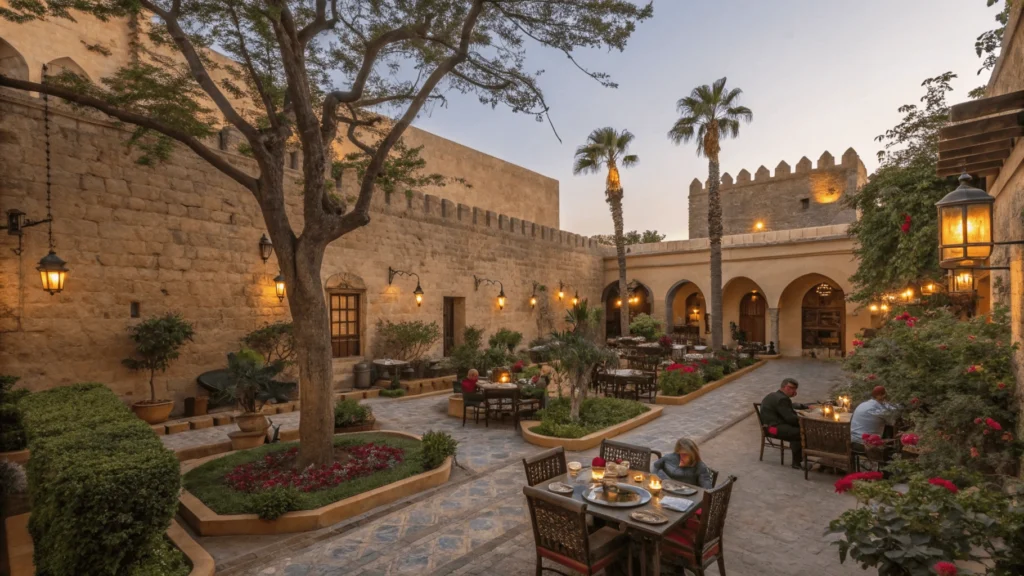
Sqala Café and Restaurant
What it is:
Set within an 18th-century fortress that once guarded the harbor, this atmospheric restaurant and café has been beautifully restored with gardens and fountains. “things to do in casablanca morocco”
Why Visit:
The fortress walls and cannons remain intact, creating a uniquely historical setting for enjoying traditional Moroccan cuisine or simply a mint tea. It’s a peaceful oasis that most tourists miss despite being near the Old Medina.
Insider Tips:
- The garden tables offer the best atmosphere, especially in the evening when lanterns are lit.
- Come for sunset drinks before dinner—the changing light on the old walls is magical.
- Their pastilla (sweet-savory pie) and tagines are excellent even by high Moroccan standards.
- Reserve ahead for dinner, especially on weekends.
- Visit the ramparts after your meal for views over the old port.
Practical Info:
- Address: Boulevard des Almohades
- Hours: Daily 12 PM to 11 PM
- Price Range: Mid-range (150-250 MAD per person for dinner)
- Getting There: At the edge of the Old Medina, near the port
Parc de la Ligue Arabe
What it is:
Casablanca’s central park, spanning over 30 acres of green space with palm-lined pathways, fountains, and gardens.
Why Visit:
This verdant sanctuary provides welcome relief from Casablanca’s concrete and offers a glimpse into local leisure life. On weekends, it fills with families, musicians, and young couples, creating a lively, authentic atmosphere. “things to do in casablanca morocco”
Insider Tips:
- Visit on Sunday afternoons when local families come out to picnic and socialize.
- The northeast corner features a small but charming traditional garden with beautiful tile work.
- Several excellent cafés border the park—Café la Paix is particularly good for people-watching.
- The Arab League Library on the grounds holds occasional exhibitions worth checking.
- Early mornings (7-9 AM) are perfect for watching elderly Moroccans practice tai chi and traditional exercises.
Practical Info:
- Address: Boulevard Moulay Youssef
- Hours: Daily 7 AM to 8 PM
- Entrance Fee: Free
- Getting There: Located in the heart of downtown, easily reached on foot from United Nations Square
Cathédrale Sacré-Coeur
What it is:
An abandoned Neo-Gothic cathedral built in the 1930s, now serving as a cultural center hosting occasional exhibitions.
Why Visit:
This architectural anomaly represents a fascinating period in Casablanca’s history. Its distinctive white concrete structure combines Gothic, Art Deco, and Moorish elements. Though no longer functioning as a church, the building’s grand scale and curious state of preservation make it a photographer’s dream. “things to do in casablanca morocco”
Insider Tips:
- The exterior is always accessible, but interior access depends on whether exhibitions are running.
- Even if closed, you can peek through windows to see the striking interior space.
- The best photographs are from the southeast corner in late afternoon light.
- The surrounding park is pleasant but somewhat neglected—stay aware of your surroundings.
- Check with your hotel about current exhibitions as information online is limited.
Practical Info:
- Address: Boulevard Rachidi
- Hours: Exterior always visible; interior open during exhibitions only
- Entrance Fee: Free (exhibitions may charge)
- Getting There: Located in downtown Casablanca, walkable from Boulevard Mohammed V
La Sqala Café Maure
What it is:
A charming traditional café set in the ramparts of an old Portuguese fortress near the harbor.
Why Visit:
With its lush garden setting, bubbling fountains, and authentic Moroccan cuisine, this hidden gem offers a peaceful retreat from the busy medina just steps away. The café occupies a historically significant location and combines excellent food with atmospheric surroundings. “things to do in casablanca morocco”
Insider Tips:
- The best tables are in the garden under the canopy of trees.
- Their mint tea service is particularly special—served with traditional ceremony.
- The seafood pastilla (seafood in flaky pastry) is a house specialty worth trying.
- Live traditional music sometimes plays in the evenings.
- Visit between lunch and dinner (around 4 PM) for the most peaceful experience.
Practical Info:
- Address: Boulevard des Almohades
- Hours: Daily 9 AM to 11 PM
- Price Range: Moderate (80-150 MAD per person)
- Getting There: Located at the edge of the Old Medina, near the port
Quartier Habous Book Market
What it is: “things to do in casablanca morocco”
A charming collection of bookstalls and small bookshops selling Arabic and French literature, religious texts, and antique books.
Why Visit:
While most visitors to Habous focus on the handicraft shops, this quiet corner of the quarter reveals Casablanca’s intellectual side. The booksellers are typically well-educated and eager to discuss literature and history even if you’re not buying. “things to do in casablanca morocco”
Insider Tips:
- Many sellers have antique maps and vintage postcards of Morocco hidden away—ask to see them.
- Visit on weekday mornings when booksellers have more time to chat.
- Look for beautiful hand-bound leather notebooks that make excellent gifts.
- Some shops in the back have rare first editions of French colonial literature about Morocco.
- Most vendors speak French; fewer speak English.
Practical Info:
- Address: Northern section of Quartier Habous
- Hours: Generally 10 AM to 6 PM, closed Friday afternoons
- Getting There: Within the Habous Quarter, near Mahkama du Pacha
Foodie Focus: Must-Try Casablanca Foods & Where to Find Them
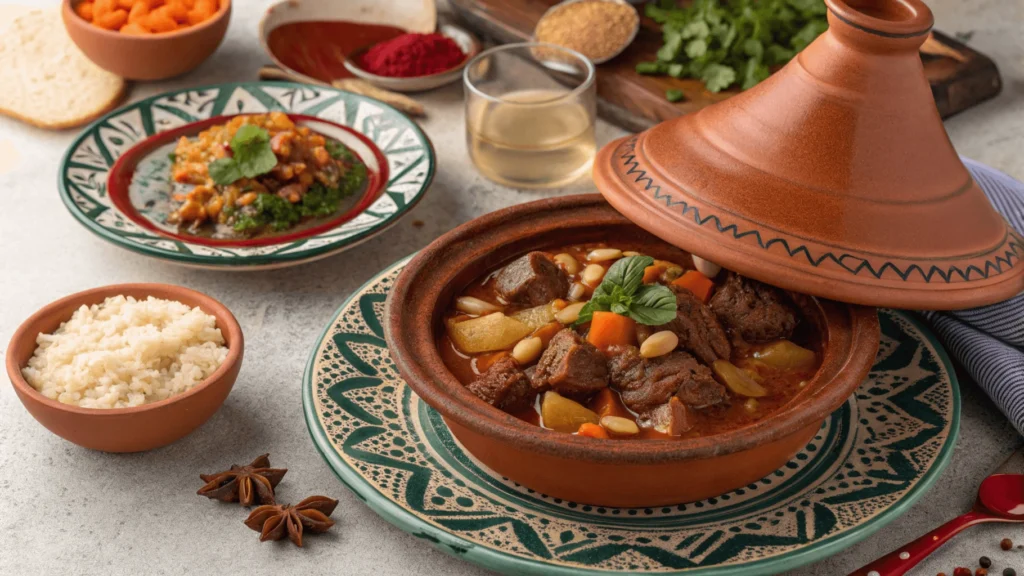
Casablanca’s food scene blends traditional Moroccan cuisine with Mediterranean influences and seafood specialties. Here’s what you shouldn’t miss: “things to do in casablanca morocco”
Classic Moroccan Dishes
| Dish | Description | Where to Try It |
|---|---|---|
| Tagine | Slow-cooked stew named after the conical clay pot it’s cooked in | Al Mounia (95 Rue Prince Moulay Abdallah) – Their lamb with prunes tagine is legendary |
| Couscous | Steamed semolina topped with vegetables and meat, traditionally served on Fridays | Restaurant Le Riad (47 Rue Tahar Sebti) – Authentic family-style Friday couscous |
| Pastilla | Sweet-savory pie with layers of thin pastry, traditionally filled with pigeon | La Sqala – Their seafood variation is a modern Casablancan specialty |
| Harira | Hearty tomato-based soup with legumes, typically eaten during Ramadan | Café M’Rabet in the Old Medina – Serves excellent harira year-round |
Casablanca Seafood Specialties
The city’s coastal location makes it Morocco’s premier destination for fresh seafood:
- Grilled Sardines: Best enjoyed at simple stalls along Ain Diab beach
- Fish Chermoula: Fresh fish marinated in a spicy herb mixture – try it at Le Cabestan
- Seafood Bastilla: A coastal adaptation of the traditional meat pastilla – La Sqala’s version is excellent
- Calamari à la Marocaine: Squid cooked with tomatoes and Moroccan spices – Port de Pêche restaurants specialize in this
Street Food Worth Trying
- Fresh Orange Juice from stands around United Nations Square – always squeezed to order
- Msemen (flaky square pancakes) from morning vendors near the Central Market
- Makouda (potato fritters) from small stands in the Old Medina
- Moroccan Donuts from the famous hole-in-the-wall bakery on Rue Allal Ben Abdellah
Cafés & Sweet Treats
- Mint Tea Ceremony: Experience the traditional pouring from height at Café la Sqala
- French-Moroccan Pastries: Patisserie Bennis in Habous Quarter makes Morocco’s finest
- Chebakia: Honey-soaked sesame cookies found in every bakery, particularly during Ramadan
- Moroccan Cookies: Paul Café near Mohammed V Square offers excellent modern interpretations
Practical Planning Guide
Getting Around Casablanca
| Transportation | Pros | Cons | Cost Estimate |
|---|---|---|---|
| Petit Taxis | Abundant, can use meter | Only take 3 passengers, limited French/English | 20-40 MAD for most city trips |
| Grand Taxis | Can share with others for economy | Fixed routes only, often crowded | 8-10 MAD per person for shared rides |
| Tramway | Modern, fixed price, avoids traffic | Limited coverage, crowded at rush hour | 7 MAD per trip regardless of distance |
| Walking | Good in specific neighborhoods | City is spread out, sidewalks often broken | Free |
| Ride Apps | Careem works well, English interface | More expensive than regular taxis | 30-60 MAD for typical trips |
Insider Tip: Petit taxis should use meters (called “compteur” in French). If the driver claims it’s broken, either negotiate a fair price before entering or find another taxi. “things to do in casablanca morocco”
Best Time to Visit Casablanca
Casablanca enjoys a moderate Mediterranean climate with distinct seasons:
- March-May (Spring): Ideal weather with mild temperatures (65-75°F/18-24°C) and blooming gardens
- June-August (Summer): Hot and humid (75-85°F/24-29°C), but good for beach activities
- September-November (Fall): Pleasant temperatures with fewer tourists
- December-February (Winter): Mild but rainy, with occasional chilly days (50-65°F/10-18°C)
Key Events: “things to do in casablanca morocco”
- Ramadan: Date varies yearly (follows lunar calendar) – Restaurants limited during day but vibrant nightlife
- Festival de Casablanca: July – Music and cultural performances throughout the city
- International Film Festival: December – Showcasing Moroccan and international cinema
- L’Boulevard Festival: September – Urban music festival featuring local talent
Suggested Itineraries
Casablanca in 1 Day (Perfect for Layovers)
- Morning: Hassan II Mosque tour (9 AM) + quick walk through Old Medina
- Lunch: Seafood at Port de Pêche or Central Market
- Afternoon: Mohammed V Square and surrounding Art Deco district
- Evening: Sunset stroll on Corniche, dinner at Rick’s Café if time permits
Casablanca in 2 Days
Day 1: “things to do in casablanca morocco”
- Morning: Hassan II Mosque tour
- Lunch: La Sqala
- Afternoon: Old Medina exploration
- Evening: Dinner and drinks on the Corniche
Day 2: “things to do in casablanca morocco”
- Morning: Quartier Habous and Royal Palace exterior
- Lunch: Traditional meal at Al Mounia
- Afternoon: Villa des Arts + Downtown Art Deco walking tour
- Evening: Shopping at Morocco Mall, seafood dinner at Ain Diab
Casablanca in 3+ Days (Relaxed Pace)
Follow the 2-day itinerary, then add:
- Day trip to El Jadida (Portuguese fortified city, UNESCO site)
- Beach day at Ain Diab or Tamaris
- Museum of Moroccan Judaism and Sacred Heart Cathedral
- Deeper exploration of food scene with a cooking class “things to do in casablanca morocco”
Safety Tips for Casablanca
While Casablanca is generally safe for tourists, keeping these tips in mind will ensure a smooth visit:
- Petty Theft: Keep valuables secure, especially in crowded areas like the medina and public transport
- Taxi Safety: Use official petit taxis (red in color) and insist on meter usage
- Solo Female Travelers: Expect some attention; dress modestly to minimize harassment
- Medina Navigation: Consider hiring a local guide if it’s your first visit
- Scams: Be wary of overly friendly “guides” who approach offering assistance
- Nighttime: Avoid unlit areas after dark; stick to main streets
- Photography: Ask permission before photographing locals, especially women
Accommodation Areas “things to do in casablanca morocco”
| Neighborhood | Best For | Notable Features |
|---|---|---|
| City Center/United Nations Square | First-time visitors, sightseeing | Central location, walkable to attractions, various price points |
| Corniche/Ain Diab | Beach lovers, upscale travelers | Oceanfront hotels, clubs, restaurants, more resort feel |
| Gauthier/Racine | Business travelers, foodies | Upscale residential area, excellent restaurants, shopping |
| Maarif | Shopping enthusiasts, mid-range budgets | Commercial district, many boutiques, cafés |
| Habous/Nouvelle Medina | Cultural immersion, budget travelers | Traditional atmosphere, local experience |
Basic Arabic/Darija Phrases
| English | Moroccan Arabic (Darija) | Pronunciation |
|---|---|---|
| Hello | Salam | sah-lahm |
| Thank you | Shukran | shoo-krahn |
| Please | Afak | ah-fak |
| Yes | Iyeh | ee-yeh |
| No | La | lah |
| How much? | B’shhal? | beh-shhal |
| Too expensive | Ghali bezzaf | rah-lee beh-zaf |
| Beautiful | Zwin | z-ween |
| Delicious | Bnin | b-neen |
| Goodbye | Bslama | beh-slah-mah |
Interactive Map
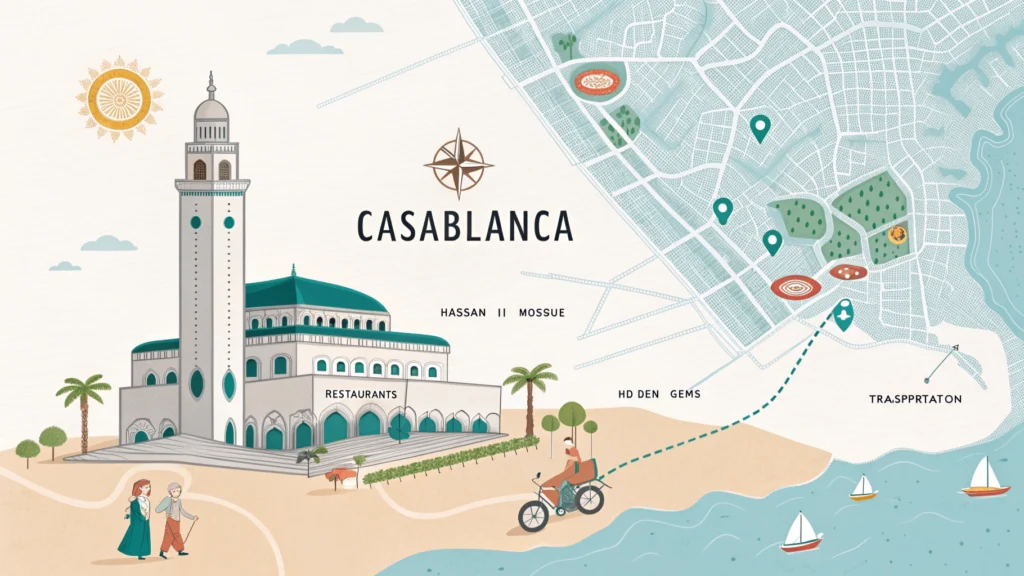
Frequently Asked Questions
Is Casablanca worth visiting compared to Marrakech/Fes?
Absolutely, but for different reasons. While Marrakech and Fes offer more traditional Moroccan experiences, Casablanca provides insight into contemporary Moroccan life, stunning architecture blending Moorish and European styles, and the country’s finest seafood. It’s less touristic and shows you the “real Morocco” that many visitors miss. “things to do in casablanca morocco”
How many days do you need in Casablanca?
Two full days allow you to see the major highlights comfortably. Three days would let you explore at a relaxed pace and include some off-the-beaten-path experiences. Those with only one day should prioritize the Hassan II Mosque, a brief medina visit, and the downtown Art Deco district.
Is Casablanca safe for tourists?
Yes, Casablanca is generally safe for tourists. Like any major city, it has areas to avoid (particularly unlit streets at night) and requires standard urban precautions against petty theft. The main tourist areas are well-policed, and violent crime against visitors is extremely rare. “things to do in casablanca morocco”
What is Casablanca best known for?
Despite popular belief, Casablanca is not best known for connections to the famous Humphrey Bogart film (which was shot entirely in Hollywood). The city is known for the magnificent Hassan II Mosque, being Morocco’s economic capital, its distinctive Art Deco architecture, and its cosmopolitan atmosphere blending French and Moroccan influences.
Can you drink alcohol in Casablanca?
Yes, alcohol is more readily available in Casablanca than in most Moroccan cities. Many restaurants, especially those catering to international clientele, serve alcohol, and there are numerous bars and clubs, particularly along the Corniche. However, public intoxication is frowned upon, and alcohol is not sold during some religious holidays. “things to do in casablanca morocco”
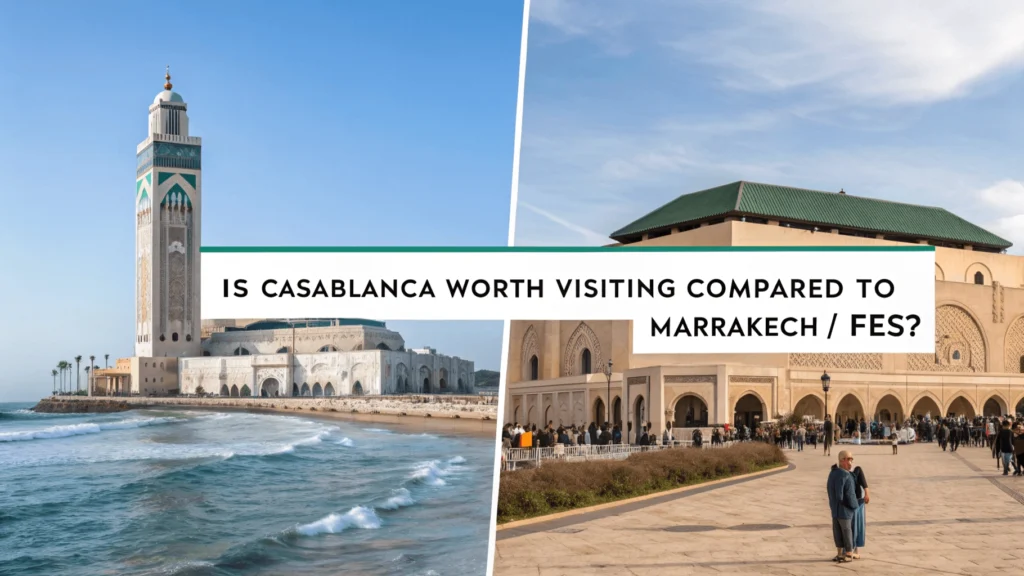
Conclusion: The Real Casablanca Awaits
Casablanca may not have the immediate charm of other Moroccan destinations, but those who give this dynamic city a chance discover a fascinating blend of traditions and modernity that represents Morocco’s future as much as its past. From architectural marvels and cultural treasures to mouthwatering cuisine and coastal pleasures, Casablanca rewards curious travelers with authentic experiences far from the usual tourist trail.
Whether you’re stopping for a quick layover or planning a deeper exploration, I hope this guide helps you discover the many faces of this misunderstood Moroccan metropolis. Casablanca isn’t just a place you pass through on the way to somewhere else—it’s a destination worth savoring in its own right. “things to do in casablanca morocco”
If you’ve visited Casablanca and have additional recommendations or questions, please share them in the comments below. Your insights help fellow travelers experience the best of this fascinating city!

